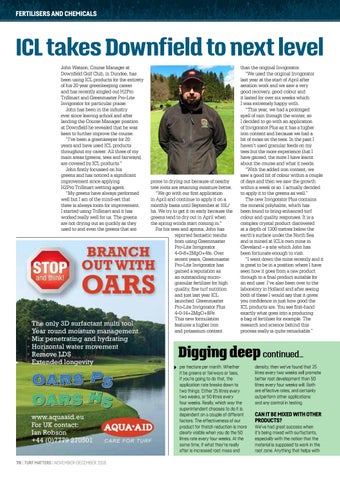FERTILISERS AND CHEMICALS
ICL takes Downfield to next level John Watson, Course Manager at Downfield Golf Club, in Dundee, has been using ICL products for the entirety of his 20 year greenkeeping career and has recently singled out H2Pro TriSmart and Greenmaster Pro-Lite Invigorator for particular praise. John has been in the industry ever since leaving school and after landing the Course Manager position at Downfield he revealed that he was keen to further improve the course. “I’ve been a greenkeeper for 20 years and have used ICL products throughout my career. All three of my main areas (greens, tees and fairways) are covered by ICL products.” John firstly focussed on his greens and has noticed a significant improvement since applying H2Pro TriSmart wetting agent. “My greens have always performed well but I am of the mind-set that there is always room for improvement. I started using TriSmart and it has worked really well for us. The greens are not drying out as quickly as they used to and even the greens that are
prone to drying out because of nearby tree roots are retaining moisture better. “We go with our first application in April and continue to apply it on a monthly basis until September at 10L/ ha. We try to get it on early because the greens tend to dry out in April when the spring winds start coming in.” For his tees and aprons, John has reported fantastic results from using Greenmaster Pro-Lite Invigorator 4-0-8+2MgO+4fe. Over recent years, Greenmaster Pro-Lite Invigorator has gained a reputation as an outstanding microgranular fertilizer for high quality, fine turf nutrition and just last year ICL launched Greenmaster Pro-Lite Invigorator Plus 4-0-14+2MgO+8Fe. This new formulation features a higher iron and potassium content
than the original Invigorator. “We used the original Invigorator last year at the start of April after aeration work and we saw a very good recovery, good colour and it lasted for over six weeks which I was extremely happy with. “This year, we had a prolonged spell of rain through the winter, so I decided to go with an application of Invigorator Plus as it has a higher iron content and because we had a bit of moss on the tees. In the past I haven’t used granular feeds on my tees but the more experience that I have gained, the more I have learnt about the course and what it needs. “With the added iron content, we saw a good bit of colour within a couple of days and then we saw the growth within a week or so. I actually decided to apply it to the greens as well.” The new Invigorator Plus contains the mineral polyhalite, which has been found to bring enhanced turf colour and quality responses. It is a complex crystal product discovered at a depth of 1300 metres below the earth’s surface under the North Sea and is mined at ICL’s own mine in Cleveland – a site which John has been fortunate enough to visit. “I went down the mine recently and it is great to be in a position where I have seen how it goes from a raw product through to a final product suitable for an end user. I’ve also been over to the laboratory in Holland and after seeing both of these I would say that it gives you confidence in just how good the ICL products are. You see first-hand exactly what goes into a producing a bag of fertiliser for example. The research and science behind this process really is quite remarkable.”
Digging deep continued… } per hectare per month. Whether
it be greens or fairways or tees, if you’re going to do that, the application rate breaks down to two things: Either 25 litres every two weeks, or 50 litres every four weeks. Really, which way the superintendent chooses to do it is dependent on a couple of different factors. The effectiveness of our product for thatch reduction is more clearly visible when you do the 50 litres rate every four weeks. At the same time, if what they’re really after is increased root mass and
70 | Turf Matters | NOVEMBER-DECEMBER 2018
density, then we’ve found that 25 litres every two weeks will promote better root development than 50 litres every four weeks will. Both are effective rates, and certainly outperform other applications and any control in testing.
Can it be mixed with other products? We’ve had great success when it’s being mixed with surfactants, especially with the notion that the material is supposed to work in the root zone. Anything that helps with
